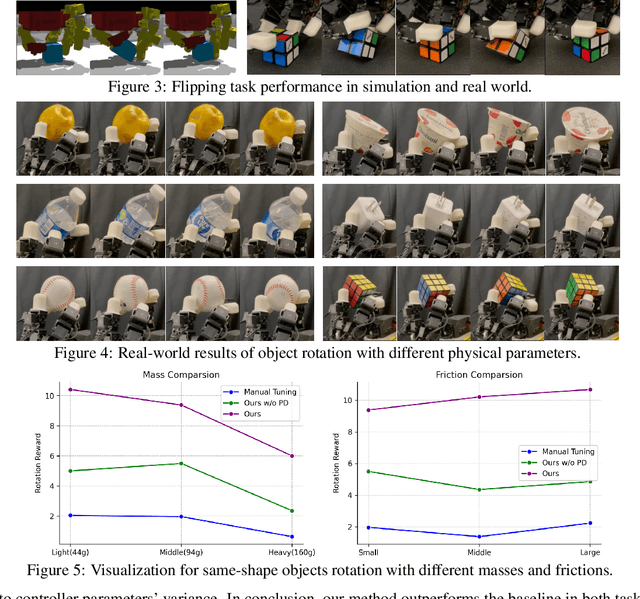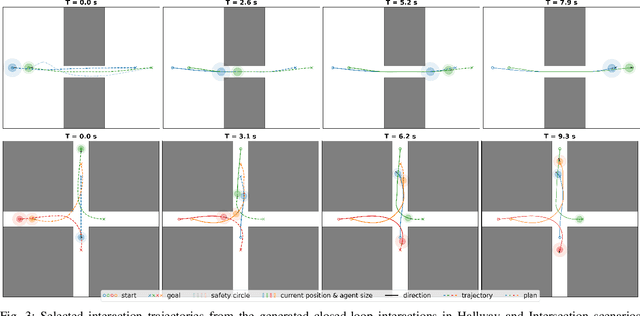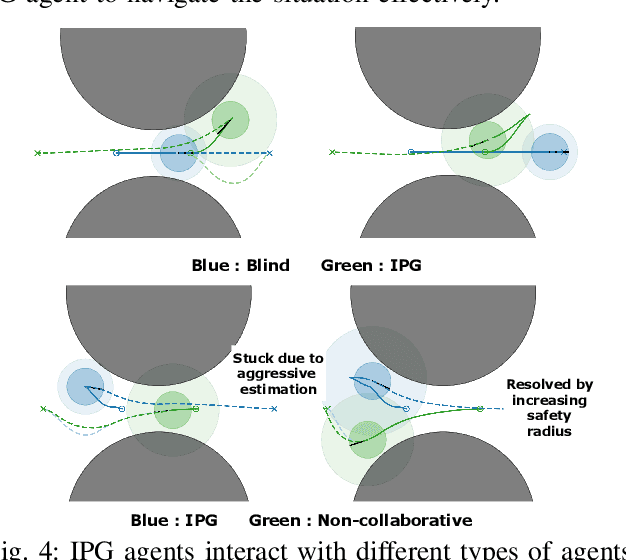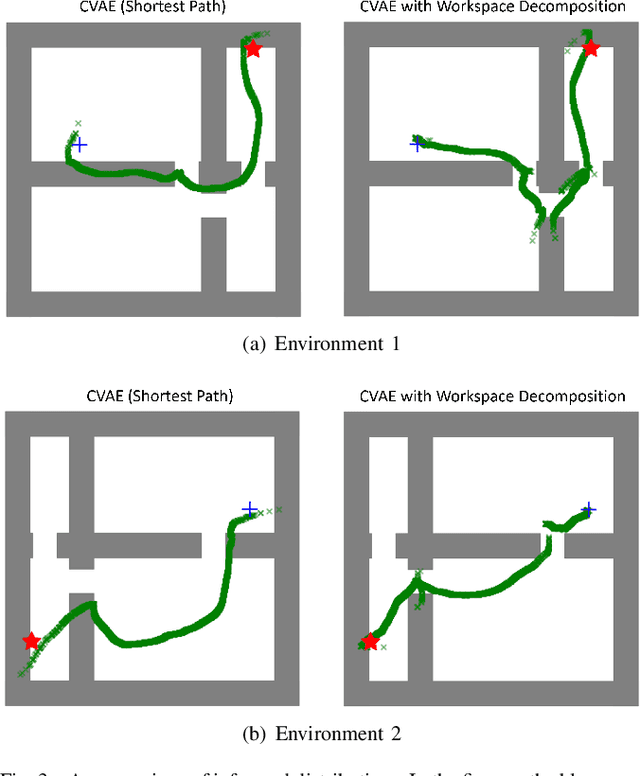Changhao Wang
DexCtrl: Towards Sim-to-Real Dexterity with Adaptive Controller Learning
May 02, 2025



Abstract:Dexterous manipulation has seen remarkable progress in recent years, with policies capable of executing many complex and contact-rich tasks in simulation. However, transferring these policies from simulation to real world remains a significant challenge. One important issue is the mismatch in low-level controller dynamics, where identical trajectories can lead to vastly different contact forces and behaviors when control parameters vary. Existing approaches often rely on manual tuning or controller randomization, which can be labor-intensive, task-specific, and introduce significant training difficulty. In this work, we propose a framework that jointly learns actions and controller parameters based on the historical information of both trajectory and controller. This adaptive controller adjustment mechanism allows the policy to automatically tune control parameters during execution, thereby mitigating the sim-to-real gap without extensive manual tuning or excessive randomization. Moreover, by explicitly providing controller parameters as part of the observation, our approach facilitates better reasoning over force interactions and improves robustness in real-world scenarios. Experimental results demonstrate that our method achieves improved transfer performance across a variety of dexterous tasks involving variable force conditions.
Geometric Retargeting: A Principled, Ultrafast Neural Hand Retargeting Algorithm
Mar 10, 2025Abstract:We introduce Geometric Retargeting (GeoRT), an ultrafast, and principled neural hand retargeting algorithm for teleoperation, developed as part of our recent Dexterity Gen (DexGen) system. GeoRT converts human finger keypoints to robot hand keypoints at 1KHz, achieving state-of-the-art speed and accuracy with significantly fewer hyperparameters. This high-speed capability enables flexible postprocessing, such as leveraging a foundational controller for action correction like DexGen. GeoRT is trained in an unsupervised manner, eliminating the need for manual annotation of hand pairs. The core of GeoRT lies in novel geometric objective functions that capture the essence of retargeting: preserving motion fidelity, ensuring configuration space (C-space) coverage, maintaining uniform response through high flatness, pinch correspondence and preventing self-collisions. This approach is free from intensive test-time optimization, offering a more scalable and practical solution for real-time hand retargeting.
DexterityGen: Foundation Controller for Unprecedented Dexterity
Feb 06, 2025



Abstract:Teaching robots dexterous manipulation skills, such as tool use, presents a significant challenge. Current approaches can be broadly categorized into two strategies: human teleoperation (for imitation learning) and sim-to-real reinforcement learning. The first approach is difficult as it is hard for humans to produce safe and dexterous motions on a different embodiment without touch feedback. The second RL-based approach struggles with the domain gap and involves highly task-specific reward engineering on complex tasks. Our key insight is that RL is effective at learning low-level motion primitives, while humans excel at providing coarse motion commands for complex, long-horizon tasks. Therefore, the optimal solution might be a combination of both approaches. In this paper, we introduce DexterityGen (DexGen), which uses RL to pretrain large-scale dexterous motion primitives, such as in-hand rotation or translation. We then leverage this learned dataset to train a dexterous foundational controller. In the real world, we use human teleoperation as a prompt to the controller to produce highly dexterous behavior. We evaluate the effectiveness of DexGen in both simulation and real world, demonstrating that it is a general-purpose controller that can realize input dexterous manipulation commands and significantly improves stability by 10-100x measured as duration of holding objects across diverse tasks. Notably, with DexGen we demonstrate unprecedented dexterous skills including diverse object reorientation and dexterous tool use such as pen, syringe, and screwdriver for the first time.
PromptMono: Cross Prompting Attention for Self-Supervised Monocular Depth Estimation in Challenging Environments
Jan 23, 2025



Abstract:Considerable efforts have been made to improve monocular depth estimation under ideal conditions. However, in challenging environments, monocular depth estimation still faces difficulties. In this paper, we introduce visual prompt learning for predicting depth across different environments within a unified model, and present a self-supervised learning framework called PromptMono. It employs a set of learnable parameters as visual prompts to capture domain-specific knowledge. To integrate prompting information into image representations, a novel gated cross prompting attention (GCPA) module is proposed, which enhances the depth estimation in diverse conditions. We evaluate the proposed PromptMono on the Oxford Robotcar dataset and the nuScenes dataset. Experimental results demonstrate the superior performance of the proposed method.
Imagined Potential Games: A Framework for Simulating, Learning and Evaluating Interactive Behaviors
Nov 06, 2024



Abstract:Interacting with human agents in complex scenarios presents a significant challenge for robotic navigation, particularly in environments that necessitate both collision avoidance and collaborative interaction, such as indoor spaces. Unlike static or predictably moving obstacles, human behavior is inherently complex and unpredictable, stemming from dynamic interactions with other agents. Existing simulation tools frequently fail to adequately model such reactive and collaborative behaviors, impeding the development and evaluation of robust social navigation strategies. This paper introduces a novel framework utilizing distributed potential games to simulate human-like interactions in highly interactive scenarios. Within this framework, each agent imagines a virtual cooperative game with others based on its estimation. We demonstrate this formulation can facilitate the generation of diverse and realistic interaction patterns in a configurable manner across various scenarios. Additionally, we have developed a gym-like environment leveraging our interactive agent model to facilitate the learning and evaluation of interactive navigation algorithms.
Efficient Sim-to-real Transfer of Contact-Rich Manipulation Skills with Online Admittance Residual Learning
Oct 16, 2023Abstract:Learning contact-rich manipulation skills is essential. Such skills require the robots to interact with the environment with feasible manipulation trajectories and suitable compliance control parameters to enable safe and stable contact. However, learning these skills is challenging due to data inefficiency in the real world and the sim-to-real gap in simulation. In this paper, we introduce a hybrid offline-online framework to learn robust manipulation skills. We employ model-free reinforcement learning for the offline phase to obtain the robot motion and compliance control parameters in simulation \RV{with domain randomization}. Subsequently, in the online phase, we learn the residual of the compliance control parameters to maximize robot performance-related criteria with force sensor measurements in real time. To demonstrate the effectiveness and robustness of our approach, we provide comparative results against existing methods for assembly, pivoting, and screwing tasks.
Generalizable whole-body global manipulation of deformable linear objects by dual-arm robot in 3-D constrained environments
Oct 15, 2023Abstract:Constrained environments are common in practical applications of manipulating deformable linear objects (DLOs), where movements of both DLOs and robots should be constrained. This task is high-dimensional and highly constrained owing to the highly deformable DLOs, dual-arm robots with high degrees of freedom, and 3-D complex environments, which render global planning challenging. Furthermore, accurate DLO models needed by planning are often unavailable owing to their strong nonlinearity and diversity, resulting in unreliable planned paths. This article focuses on the global moving and shaping of DLOs in constrained environments by dual-arm robots. The main objectives are 1) to efficiently and accurately accomplish this task, and 2) to achieve generalizable and robust manipulation of various DLOs. To this end, we propose a complementary framework with whole-body planning and control using appropriate DLO model representations. First, a global planner is proposed to efficiently find feasible solutions based on a simplified DLO energy model, which considers the full system states and all constraints to plan more reliable paths. Then, a closed-loop manipulation scheme is proposed to compensate for the modeling errors and enhance the robustness and accuracy, which incorporates a model predictive controller that real-time adjusts the robot motion based on an adaptive DLO motion model. The key novelty is that our framework can efficiently solve the high-dimensional problem subject to multiple constraints and generalize to various DLOs without elaborate model identifications. Experiments demonstrate that our framework can accomplish considerably more complicated tasks than existing works, with significantly higher efficiency, generalizability, and reliability.
Distributed Multi-agent Interaction Generation with Imagined Potential Games
Oct 02, 2023Abstract:Interactive behavior modeling of multiple agents is an essential challenge in simulation, especially in scenarios when agents need to avoid collisions and cooperate at the same time. Humans can interact with others without explicit communication and navigate in scenarios when cooperation is required. In this work, we aim to model human interactions in this realistic setting, where each agent acts based on its observation and does not communicate with others. We propose a framework based on distributed potential games, where each agent imagines a cooperative game with other agents and solves the game using its estimation of their behavior. We utilize iLQR to solve the games and closed-loop simulate the interactions. We demonstrate the benefits of utilizing distributed imagined games in our framework through various simulation experiments. We show the high success rate, the increased navigation efficiency, and the ability to generate rich and realistic interactions with interpretable parameters. Illustrative examples are available at https://sites.google.com/berkeley.edu/distributed-interaction.
Robot Manipulation Task Learning by Leveraging SE(3) Group Invariance and Equivariance
Aug 29, 2023



Abstract:This paper presents a differential geometric control approach that leverages SE(3) group invariance and equivariance to increase transferability in learning robot manipulation tasks that involve interaction with the environment. Specifically, we employ a control law and a learning representation framework that remain invariant under arbitrary SE(3) transformations of the manipulation task definition. Furthermore, the control law and learning representation framework are shown to be SE(3) equivariant when represented relative to the spatial frame. The proposed approach is based on utilizing a recently presented geometric impedance control (GIC) combined with a learning variable impedance control framework, where the gain scheduling policy is trained in a supervised learning fashion from expert demonstrations. A geometrically consistent error vector (GCEV) is fed to a neural network to achieve a gain scheduling policy that remains invariant to arbitrary translation and rotations. A comparison of our proposed control and learning framework with a well-known Cartesian space learning impedance control, equipped with a Cartesian error vector-based gain scheduling policy, confirms the significantly superior learning transferability of our proposed approach. A hardware implementation on a peg-in-hole task is conducted to validate the learning transferability and feasibility of the proposed approach.
Learning from Local Experience: Informed Sampling Distributions for High Dimensional Motion Planning
Jun 15, 2023



Abstract:This paper presents a sampling-based motion planning framework that leverages the geometry of obstacles in a workspace as well as prior experiences from motion planning problems. Previous studies have demonstrated the benefits of utilizing prior solutions to motion planning problems for improving planning efficiency. However, particularly for high-dimensional systems, achieving high performance across randomized environments remains a technical challenge for experience-based approaches due to the substantial variance between each query. To address this challenge, we propose a novel approach that involves decoupling the problem into subproblems through algorithmic workspace decomposition and graph search. Additionally, we capitalize on prior experience within each subproblem. This approach effectively reduces the variance across different problems, leading to improved performance for experience-based planners. To validate the effectiveness of our framework, we conduct experiments using 2D and 6D robotic systems. The experimental results demonstrate that our framework outperforms existing algorithms in terms of planning time and cost.
 Add to Chrome
Add to Chrome Add to Firefox
Add to Firefox Add to Edge
Add to Edge